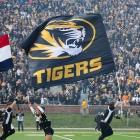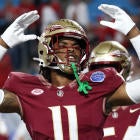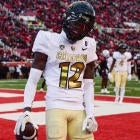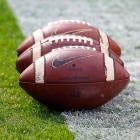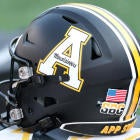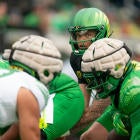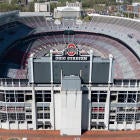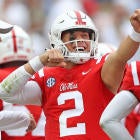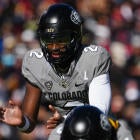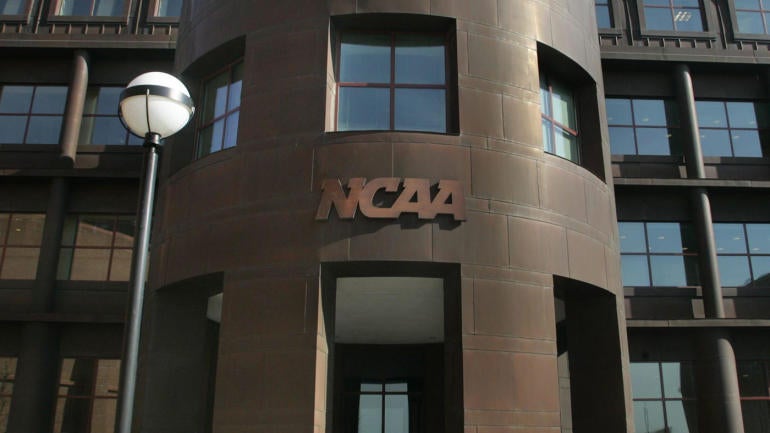
SCOTTSDALE, Ariz. -- Less than three months away from what it supposed to signal the biggest transformation in NCAA history, the associations' 21-member Transformation Committee -- a group charged with rewriting the NCAA constitution -- doesn't have a clear picture of what there is to rewrite.
An enforcement model that the conferences are supposed to take over is like a stalled car stuck on the side of the highway, and the NCAA enforcement division hasn't moved much to intervene as the collegiate model has degraded around them.
Eyes collectively rolled at the Fiesta Summit this week when news emerged the NCAA was getting serious about booster collectives that have sprouted in the name, image and likeness era.
Most notably, a reported demand for more NIL benefits by Miami guard Isaiah Wong evolved after Kansas State transfer guard Nigel Pack got an $800,000 NIL deal from Miami booster John Ruiz. Pittsburgh wide receiver Jordan Addison also last week became the poster child for the vagaries of the transfer climate. Addison entered the transfer portal after reportedly being propositioned with a multi-million NIL deal that looks suspiciously like an inducement from USC. (Sources told CBS Sports on Wednesday that Texas believes it has a chance to land the Biletnikoff Award winner, who has two years of eligibility remaining.)
"Let's be candid: That's where this game is headed," Texas coach Steve Sarkisian said of the NIL climate. "If that's the way things are going, we've got to adapt to the times. The old adage: 'You adapt or you die.' There's no more dinosaurs on this Earth."
The NCAA Transformation Committee has until Aug. 1 to turn around an aircraft carrier by deregulating college athletics to the point that the association is a bit player in a much larger production. Few sources consulted for this story believe that deadline has a chance of being to be met.
Worse, the emerging NIL market isn't technically a talking point for the group at this momentous place in college history.
"There may be some work finished by Aug. 1, but it won't be a completed process," a committee member told CBS Sports. "I don't think anybody has any delusions that it's going to be buttoned up with a bow on it."
The implications are massive. NIL is sucking the oxygen out of the meeting rooms at the Fiesta Summit, a series of conference spring meetings. Coaches and administrators alike expressed frustration this week, but almost everyone has come to the same conclusion: NIL is here to stay.
"They say it's like the Wild, Wild West," said one Power Five coach. "Who won the Wild, Wild West? Bandits, pirates, criminals. When there is looting in the streets and chaos, who wins? The guys who break windows and runs out of Walmart with TVs."
NIL isn't necessarily a bullet point for the committee, but it may be the single biggest factor that will shape college athletics going forward.
After Aug. 1, does that committee disband? Does the NCAA ask high-powered, important administrators to stay and complete the work? That's quite an ask by an NCAA, which all but ignored work done over two years by a blue-ribbon working group tasked with developing NIL guidelines.
"It will be interesting to see what remains and the board's interest in continuing the work," said SEC commissioner Greg Sankey, co-chair of the transformation committee.
That suggests the transformation may be more of a concept than a committee in the future. Given the emergence of NIL, there is another subgroup that must be considered here. Athletes are allowed to have NFL agents as NIL marketing agents. South Carolina quarterback Spencer Rattler uses Patrick Mahomes' agent as his NIL advisor.
There is a growing groupthink among college stakeholders that even more blatant pay-for-play is right around the corner. NIL is just the first early iterations of what it might look like.
"I don't think it's unsustainable; I just think it will evolve," said exiting Big 12 commissioner Bob Bowlsby, a member of that NIL working group. "There are going to be a few people that make a lot of people. There are going to be a few people that make some money. There are going to be a whole bunch of people who don't make any money."
Not much has changed. Bowlsby pointed to the 1929 Carnegie report on college athletics that could have been written in 2022. Among the findings? Recruits were given cushy jobs and coaches made too much money. My, how times have not changed.
"I feel a little like an escapee," said the 70-yard-old Bowlsby, who is retiring this year, while speaking in general terms about the current NCAA landscape. "You think of it in 'Shawshank Redemption' terms. I'm out of the 500-yard sewer. I'm in the rainwater, but I don't have my dirty clothes off yet."
Meanwhile, the existing issues for the transformation committee alone are huge. Add in other external forces like SB 1401 in California -- a bill that would essentially remove any NIL limitation -- and the situation only gets more complicated.
Don't scoff. What started in California a few years ago as the nation's first NIL bill turned into the blueprint for other states' legislation. The momentum forced the NCAA last July to issue "interim" NIL rules that were really a list of unenforceable guidelines.
Other cases being litigated include one which wishes to classify athletes as employees and another in which college athletes are essentially suing the NCAA for back pay as NIL opportunities, they say, were unfairly blocked by the association previously.
While some of these cases may take years to wind their way through the courts, the point has already been made: The duties of the transformation committee can't possibly account for all of it.
The NCAA used to be too big to fail. Now, the momentum toward a structured employee-employer relationship is too big to be ignored.
"Many of the decisions we will make here over the next 6-12 months will impact college athletics for the next 25-30 years," Big Ten commissioner Kevin Warren said. "Because of that, we need to be thoughtful. The worst thing we can do is rush into this."
Meanwhile, with NIL blooming like algae, the momentum is toward less oversight, not more. One enforcement tactic being considered is applying what would largely be financial penalties so substantial that they significantly cut into the athletic budget of a school.
One source close to those discussions suggested a Level 1 violation (the most extreme) could equate to a fine that equals 10% of an overall athletic department budget. Certainly, 10% of a $150 million budget ($15 million) would get a school's attention … if the school didn't sue in this litigious environment.
"If postseason bans go away, then we need to look at fine circumstances," said Sankey. "Yeah, I think that changes behavior.
"If you take basketball and everyone is chasing the brass ring of the NCAA Tournament and you negatively impact the finances, big school or small school, I think you'd capture people's attention immediately."
The question: In this NIL world, is there any number that would dissuade schools from "cheating"?
Before any of that occurs, there must be some accounting of NIL permanently in the system. There is no question athletes have never had it better, and that's a good thing. Quality of medical care, nutrition, training, equipment and overall workplace environment are at all-time highs. So is player empowerment brought about, in part, by NCAA missteps.
"There are two definitely separate conversations," Fresno State athletic director Terry Tumey said, "but all going towards the fact that the relationship of student-athletes to institutions has changed."
The entire enterprise is in upheaval because the membership didn't pay more attention to the basic rights of its labor force. Twice in the last decade, the NCAA has been found guilty of federal antitrust violations. The last one, Alston v. NCAA last June, left the organization a shell of itself.
In its place, the new power brokers are attorneys, well-healed boosters and collective owners -- armed with enough money and influence to take on whatever clout the NCAA has remaining.
Tumey is a veteran of the current landscape. A few years ago, a pair of South Bend, Indiana, natives, Hanna and Haley Cavinder, picked Fresno State to further their basketball careers. Those careers changed forever when NIL hit and the twins were able to capitalize on their marketability by signing seven-figure endorsement deals. They also inked lucrative NIL deals with WWE. The Cavinders recently transferred, as a pair, to Miami -- at least in part to further their off-court opportunities.
That's the same Miami that caused a stir in the last week with those male basketball players and their NIL possibilities. Fresno State could do nothing but wish good luck to Haley, the Mountain West Player of the Year, and her sister.
"What all of this is doing is making institutions define who they are," Tumey added. "Where do we fit in this landscape of college athletics? The landscape has definitely turned. There's a different appreciation for what we do."
Seven years ago, Notre Dame AD Jack Swarbrick told CBS Sports that college athletics would fragment along a line between schools that adhere to the strict collegiate model and a more compensatory model. This was, of course, six years before NIL. He was prescient.
The work being undertaken by the transformation committee almost pales in comparison to the larger conversation.
In the next few months, roster sizes are expected to expand. Coaching staff sizes will be unlimited. The 400-plus pages of that NCAA rule book may be edited down to a few dozen. Divisions and conferences alone could decide sports sponsorship numbers. The minimum is 16, as defined by the NCAA. Who's to keep the SEC from raising that number to 20?
Those subtle changes foreshadow another fault line. The incongruities between the Power Five and Group of Five grow by the day. By the end of the month, Big Ten teams may be making $80 million per school in annual TV rights revenue. Compare that to the Sun Belt, which has teams pulling in $500,000 annually.
No wonder market forces have evolved to create NIL.
"It's a different world than what I've ever known in my years in the business," Kansas basketball coach Bill Self said. "A lot of time, different becomes uncertainty and uncertainty becomes doubt. I don't see a lot of positives right now with the portal and NIL stuff. But if you really evaluate it from 40,000 feet, there are some positives. There are some good things. But we look at how it affects us."
The transformation of college athletics will continue to be painful. Perhaps this is the end of decades-long problems because Division III schools were allowed to vote on issues that impact Alabama football and North Carolina basketball.
That remains big part of the discussion: deregulation. There was some consternation that all 32 Division I conferences weren't represented on the transformation committee.
By omitting some leagues, the board answered the questions of membership subtly: You may not matter. That suggests a subdivision of Division I that has been discussed throughout this process. The fear, by some, is that all 32 conferences won't have automatic qualifiers to the NCAA Tournament.
There already is power coalescing around the SEC and Big Ten becoming the Power Two among the Power Five. They make the most money and have the biggest brands. There is the feeling that whatever those leagues want will ultimately happen. Cut 50 teams out of FBS? It could happen, but probably not right away.
However, lingering in the halls of the Hyatt Regency Gainey Ranch Resort & Spa this week was the overriding thought that it is absolutely possible.
The new look of the whatever the NCAA becomes may not even include football. The College Football Playoff could run the sport. It is already an LLC that has distributed $7 billion over the first 12 years of its existence.
Those who might most affect change don't seem to be interested. Duke coach Mike Krzyzewski's rant about the NCAA at the Final Four was followed with this question: Would you ever consider being involved in any of this in retirement?
"Not in a formal basis," he said.
That's part of the problem. There aren't enough leaders.
Former Big Ten commissioner Jim Delany once threatened his league would drop down to Division III if players were compensated. With the Big 12 reorganizing, the ACC stuck in a long-term undervalued contract, and the Pac-12 at a competitive disadvantage, whatever evolves will be led financially, physically and philosophically by Delany's old conference and the SEC.
For now, think more conservatively. The transformation committee could implement a "floor" of qualifications that it takes to remain at the Division I level. Think of sports sponsorship at a university level. Raise the minimum from 16 to 20, and a lot of schools couldn't afford it. Others would be hanging on by a thread financially.
Bottom line: Alabama might need Austin Peay as a football opponent in November, but it doesn't necessarily want it in Division I voting on the same issues.
Five years ago, when this issue was swirling, CBS Sports priced a Group of Five playoff with the help of Northern Illinois AD Sean Frazier. Back then, Frazier was doubling down on the Group of Five going it alone in a playoff.
"All I'm saying is the directional schools like us, it's just a matter of time," said Frazier, a former Alabama walk-on. "I'm not Nostradamus, but shoot, I'm looking at the trends. ... My donor base is [maxed] out. ... If I don't find new ways to monetize ... one major [solution] is this potential playoff."
Remember, that was five years ago. Since then, Frazier's Huskies have gone 30-29 in football, won two MAC titles and had three players drafted. Defending national champion Georgia won its first title in 41 years and had 15 players drafted last weekend alone.
"If FBS broke completely from the NCAA and was governed by [the CFP], it would take about a minute and a half for all the basketball [teams to break away], too,' one transformation committee member said. "Then, the whole thing is done."
Whether that ultimately happens, there is one emerging truth that will endure: May the best NIL deal win.













